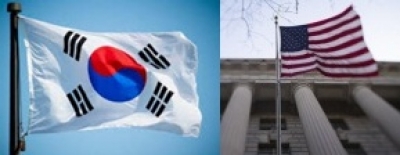South Korea averts worst-case scenario with US tariff deal
By IANS | Updated: July 31, 2025 09:24 IST2025-07-31T09:17:03+5:302025-07-31T09:24:42+5:30
Seoul, July 31 South Korea's latest tariff agreement with the United States, as favourable as those secured by ...

South Korea averts worst-case scenario with US tariff deal
Seoul, July 31 South Korea's latest tariff agreement with the United States, as favourable as those secured by major trading rivals, is expected to provide immediate relief for its export-driven economy, though the country needs to brace for the impact of evolving trade norms on key sectors and the broader economy, experts said on Thursday.
Earlier in the day, the two nations announced a bilateral trade agreement that sets a 15 per cent tariff on South Korean exports to the U.S., against the initially expected 25 percent, and includes a pledge for US$350 billion in South Korean investment in the U.S. shipbuilding, energy and other sectors, reports Yonhap news agency.
The deal also applied the 15 percent tariffs on automobiles, down from the current 25 percent, while South Korea avoided additional U.S. market access demands in such sensitive sectors as beef and rice. The new arrangement is set to take effect Friday (U.S. time).
"We have overcome a significant hurdle," President Lee Jae Myung said in his Facebook post. "The agreement eliminates uncertainty in our export environment and creates conditions to compete on equal or better terms with major countries."
Earlier this week, the U.S. and Japan reached a framework trade agreement establishing 15 percent tariffs, while the European Union also locked in a 15 percent levy. The export structures of Japan and the EU to the U.S. closely resemble that of South Korea.
Despite offering some relief, the new tariff scheme is expected to further dampen South Korea's exports to the U.S. and elsewhere, at least in the short term, the experts noted.
In the first half of this year, South Korean shipments to the U.S. fell 3.7 percent on-year to $62.18 billion, as car exports plunged 16.8 percent and sales of machinery dipped 16.9 percent.
"Exports to the U.S. have continued to decline, with particularly steep drops in automobiles and steel, both subject to item-specific tariffs. Our trade surplus with the U.S. is also shrinking," industry ministry official Seo Ga-ram said.
"The impact of U.S. tariffs is being felt even more acutely in the field than the figures suggest. Slowing exports from China to the U.S. have also dragged down our component exports to China," he added.
South Korea's overall exports edged down 0.03 percent from a year earlier in the first six months of 2025 to $334.7 billion, which still marked the third-highest level of exports in any first half, after those of 2022 and 2024.
However, officials note that the better-than-anticipated first-half figure was, at least in part, due to front-loaded demand ahead of anticipated tariff increases.
A potential slowdown in exports is feared to weigh further on the domestic economy amid sluggish consumption.
"Starting from the third quarter, the impact of U.S. tariffs is likely to become more pronounced," said Lee Dong-won, an official at the Bank of Korea (BOK). "Economic growth may slow further under the 15 percent tariff scheme."
The central bank earlier forecast the local economy to expand by 0.8 percent this year, following 2 percent year-on-year growth in 2024.
In the second quarter, the country's real gross domestic product (GDP), a key indicator of economic growth, rose 0.6 percent, rebounding from an unexpected 0.2 percent contraction in the first quarter. The BOK is scheduled to release its latest growth outlook for the year next month.
Companies are scrambling to assess the impact of the new agreement, amid growing concerns that the trade advantages South Korea had secured under its bilateral free trade agreement (FTA) with the U.S. may have effectively been nullified, particularly in the automotive sector.
South Korean automobiles had entered the U.S. market tariff-free under the KORUS FTA, while Japanese and European vehicles faced a 2.5 percent tariff.
"We pushed for 12.5 percent until the very end," said Kim Yong-beom, the presidential chief of staff for policy. "But insisting on 12.5 percent would have destabilised other frameworks."
The presidential official added, "The FTA itself is already under considerable strain.”
Disclaimer: This post has been auto-published from an agency feed without any modifications to the text and has not been reviewed by an editor
Open in app